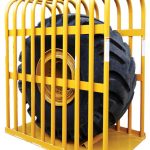Ken-Tool's history begins in 1920 when John A. Kennedy, self-proclaimed tire changing champion of the world, invented the Pacific Rim Tool. This revolutionary tire changing tool, endorsed by the B. F. Goodrich Company, began selling to garages and tire shops throughout the country. At this time, Kennedy had no manufacturing capability, so in 1925 he formed a partnership with J. Frank Kemmerline of the Cornwell Tool Company, and officially started the Kennedy Tool Company. Their primary product was the now-famous Pacific Rim Tool. During the next year, 1926, over 100,000 of these tools were shipped from their Ohio plant, and over 20,000 units were shipped from a Birmingham, England plant through the export division of General Motors.
 Over the next 12 years, car registration continued to increase, people were driving their cars more frequently, and automotive service was becoming a rapidly growing business. As the aftermarket grew, so did the Kennedy Company. Jack Kennedy and Frank Kemmerline expanded their product line with new tire service tools and equipment. The business survived the depression and operated fairly successfully until 1938.
Over the next 12 years, car registration continued to increase, people were driving their cars more frequently, and automotive service was becoming a rapidly growing business. As the aftermarket grew, so did the Kennedy Company. Jack Kennedy and Frank Kemmerline expanded their product line with new tire service tools and equipment. The business survived the depression and operated fairly successfully until 1938.
In 1938, problems began to develop between Kennedy and Kemmerline. Kemmerline wanted to expand the business to include other product lines, while Kennedy wanted to focus on only the tire tool business. The differences could not be worked out, so Kennedy left the business in pursuit of new opportunities.
He soon made contact with 31-year-old John Lydle, who only three years earlier had opened his own enterprise, The Rittman Tool and Forge Company, in Rittman, Ohio. Kennedy convinced Lydle to join him, and in the late summer of 1938, the Ken-Tool Company was formed. Because of his worldwide reputation in the tire changing industry, Kennedy was named president of Ken-Tool and his name was advertised as being the founder of the company. However, within six months of the start of this new venture, Kennedy died, and John Lydle took full control of Ken-Tool.
During this same time, Frank Kemmerline at Cornwell continued to operate the Kennedy Tool Company, and obtained a court order prohibiting Ken-Tool from making any reference to the name Kennedy. These two companies were now fierce competitors, and between them virtually owned the tire tool business.
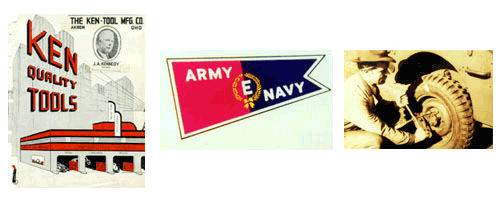
The forties brought World War II, and new challenges as U.S. industry geared up for the war effort. During the war, Ken-Tool developed a special tool to remove tires from the rims of B-29 bombers. This was a unique and costly problem for the Air Corps because of the tremendous heat generated when landing in Northern Africa. Before this tool was developed, planes were literally grounded in the desert because there was no way to remove their tires, which had actually cured themselves to the rims. Lydle received his first patent for this rim tool and was awarded the Army E award by the war department. A second E Award was earned by Ken-Tool for manufacturing forged firing pins for large guns, and an unprecedented third E Award was given for developing special tire and wheel tools for jeeps and other military vehicles.
When the war ended, Frank Kemmerline was still operating Kennedy Tool, which had now expanded its offering and was selling a broad line of service and hand tools.
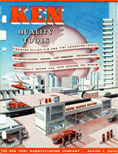 As the forties ended, Ken-Tool also prospered. With John Lydle's continued focus on the development and introduction of more tire changing tools supported by a strong market presence at national and regional trade shows as well as innovative promotional and merchandising activities, Ken-Tool began to rapidly capture market share, and soon became the dominant supplier in the marketplace.
As the forties ended, Ken-Tool also prospered. With John Lydle's continued focus on the development and introduction of more tire changing tools supported by a strong market presence at national and regional trade shows as well as innovative promotional and merchandising activities, Ken-Tool began to rapidly capture market share, and soon became the dominant supplier in the marketplace.
In 1956, a major event took place that would play a dramatic roll in Ken-Tool's future. Frank Kemmerline sold the Cornwell Tool Company. The new company's focus was the manufacture of mechanic's hand tools sold through captive mobile distribution. In 1958, Cornwell Tool sold their Kennedy Tool Company to none other than Ken-Tool. John Lydle now owned and operated both companies and gained complete control of the U. S. tire tool business. He continued to operate the two companies separately, allowing the market to believe they were still two separate, competing companies.
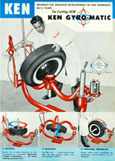 Kennedy Tool, now under John Lydle's direction, continued to expand its offering by adding allied product lines from other manufacturers. Ken-Tool, on the other hand, continued its focus on tire changing, and soon introduced one of the first tire changing machines in the industry, the Ken-Tool Gyro-Matic. Finally, in the late fifties, Lydle decided to combine the Kennedy and Ken-Tool product lines. Now both companies offered the same lines of product, but still through separate sales organizations and separate distributors. In those days of exclusive distribution rights, it was not uncommon to sell Ken-Tool to distributor A on an exclusive basis, and sell Kennedy Tool to distributor B across the street, also on an exclusive basis!
Kennedy Tool, now under John Lydle's direction, continued to expand its offering by adding allied product lines from other manufacturers. Ken-Tool, on the other hand, continued its focus on tire changing, and soon introduced one of the first tire changing machines in the industry, the Ken-Tool Gyro-Matic. Finally, in the late fifties, Lydle decided to combine the Kennedy and Ken-Tool product lines. Now both companies offered the same lines of product, but still through separate sales organizations and separate distributors. In those days of exclusive distribution rights, it was not uncommon to sell Ken-Tool to distributor A on an exclusive basis, and sell Kennedy Tool to distributor B across the street, also on an exclusive basis!
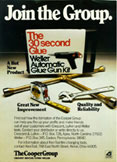 The sixties and seventies brought about much turmoil and change for both America and Ken-Tool. In May of 1966, 28 years after founding Ken-Tool, John Lydle sold the company to Cooper Industries of Houston, Texas. Ken-Tool was the third non-energy- service venture of Cooper and their first hand tool acquisition. In 1970, Ken-Tool became one of the original members of the Cooper Tool Group, along with Crescent hand tools, Weller soldering guns and Lufkin tape measures and rules. In 1971 Ken-Tool began selling these products to the automotive aftermarket as Cooper's only aftermarket distribution arm. As Ken-Tool became Cooper-ized, other significant changes began to take place. Most of the non-Cooper buy-for-resale items were dropped from the line as focus was placed on those items of Ken-Tool's manufacture, and in 1972, the Kennedy brand of product was discontinued for good. The Ken-Tool line was now 95% product of its own manufacture, one brand, and a springboard to sell other Cooper products to the aftermarket.
The sixties and seventies brought about much turmoil and change for both America and Ken-Tool. In May of 1966, 28 years after founding Ken-Tool, John Lydle sold the company to Cooper Industries of Houston, Texas. Ken-Tool was the third non-energy- service venture of Cooper and their first hand tool acquisition. In 1970, Ken-Tool became one of the original members of the Cooper Tool Group, along with Crescent hand tools, Weller soldering guns and Lufkin tape measures and rules. In 1971 Ken-Tool began selling these products to the automotive aftermarket as Cooper's only aftermarket distribution arm. As Ken-Tool became Cooper-ized, other significant changes began to take place. Most of the non-Cooper buy-for-resale items were dropped from the line as focus was placed on those items of Ken-Tool's manufacture, and in 1972, the Kennedy brand of product was discontinued for good. The Ken-Tool line was now 95% product of its own manufacture, one brand, and a springboard to sell other Cooper products to the aftermarket.
As Cooper Industries continued its acquisition activities, the companies it bought were less and less oriented to the automotive aftermarket, and so in the early seventies, the decision was made to sell Ken-Tool. The company was put on the market, and in April 1974, sold to Warren Tool Corporation in Warren, Ohio, a small, privately-owned manufacturer of vises, clamps and heavy striking tools. Under Warren Tool, Ken-Tool quickly dropped the product lines from Cooper and replaced them with those of its new sister divisions, Columbian vises, Warren striking tools, and Hargrave clamps. Three years later, Warren acquired Kal-Equip Company, a manufacturer of automotive diagnostic test equipment, and formed a new organization, The Warren Automotive Group. Now a customer could buy from one source, five different product lines, all sold and marketed by one sales organization, shipped as one shipment, and billed on one invoice. But, after several frustrating years in the test equipment business, Warren Tool made the decision to sell Kal-Equip and re-establish Ken-Tool as a free standing, autonomous division of the Warren Tool Corporation. That structure continued until 1994, when all other Warren Tool operations were sold, leaving Ken-Tool as an entirely independent company.
A lot of change has occurred within Ken-Tool over the years, from its beginning with the innovative Pacific Rim Tool, through a variety of other product lines, affiliations, and ownerships. But throughout that period, its long-time slogan, "Wherever Tires Are Changed", has held true. Ken-Tool's brand name and reputation remain the best in the tire-service industry, and it is the passion of the company's leaders to make sure that continues to be true in the years ahead.

